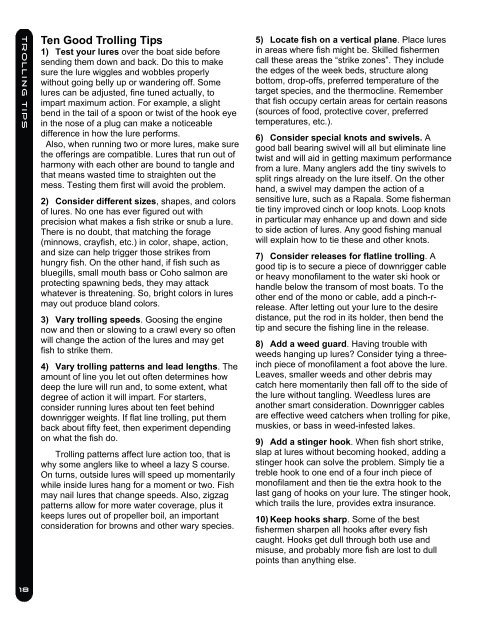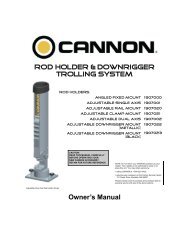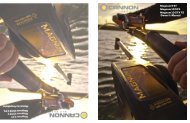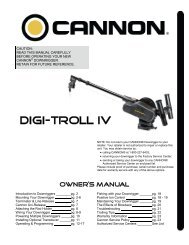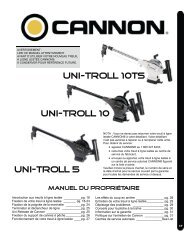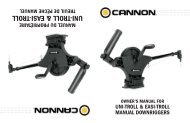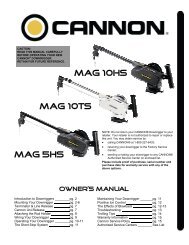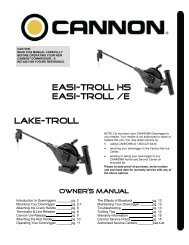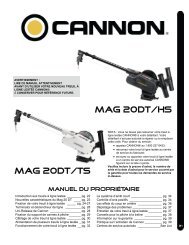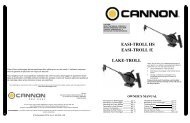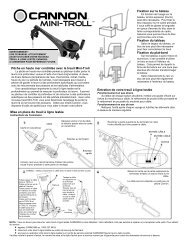Mag 20DT/HS Manual - Cannon Downriggers
Mag 20DT/HS Manual - Cannon Downriggers
Mag 20DT/HS Manual - Cannon Downriggers
You also want an ePaper? Increase the reach of your titles
YUMPU automatically turns print PDFs into web optimized ePapers that Google loves.
TROLLING TIPS<br />
Ten Good Trolling Tips<br />
1) Test your lures over the boat side before<br />
sending them down and back. Do this to make<br />
sure the lure wiggles and wobbles properly<br />
without going belly up or wandering off. Some<br />
lures can be adjusted, fine tuned actually, to<br />
impart maximum action. For example, a slight<br />
bend in the tail of a spoon or twist of the hook eye<br />
in the nose of a plug can make a noticeable<br />
difference in how the lure performs.<br />
Also, when running two or more lures, make sure<br />
the offerings are compatible. Lures that run out of<br />
harmony with each other are bound to tangle and<br />
that means wasted time to straighten out the<br />
mess. Testing them first will avoid the problem.<br />
2) Consider different sizes, shapes, and colors<br />
of lures. No one has ever figured out with<br />
precision what makes a fish strike or snub a lure.<br />
There is no doubt, that matching the forage<br />
(minnows, crayfish, etc.) in color, shape, action,<br />
and size can help trigger those strikes from<br />
hungry fish. On the other hand, if fish such as<br />
bluegills, small mouth bass or Coho salmon are<br />
protecting spawning beds, they may attack<br />
whatever is threatening. So, bright colors in lures<br />
may out produce bland colors.<br />
3) Vary trolling speeds. Goosing the engine<br />
now and then or slowing to a crawl every so often<br />
will change the action of the lures and may get<br />
fish to strike them.<br />
4) Vary trolling patterns and lead lengths. The<br />
amount of line you let out often determines how<br />
deep the lure will run and, to some extent, what<br />
degree of action it will impart. For starters,<br />
consider running lures about ten feet behind<br />
downrigger weights. If flat line trolling, put them<br />
back about fifty feet, then experiment depending<br />
on what the fish do.<br />
Trolling patterns affect lure action too, that is<br />
why some anglers like to wheel a lazy S course.<br />
On turns, outside lures will speed up momentarily<br />
while inside lures hang for a moment or two. Fish<br />
may nail lures that change speeds. Also, zigzag<br />
patterns allow for more water coverage, plus it<br />
keeps lures out of propeller boil, an important<br />
consideration for browns and other wary species.<br />
5) Locate fish on a vertical plane. Place lures<br />
in areas where fish might be. Skilled fishermen<br />
call these areas the “strike zones”. They include<br />
the edges of the week beds, structure along<br />
bottom, drop-offs, preferred temperature of the<br />
target species, and the thermocline. Remember<br />
that fish occupy certain areas for certain reasons<br />
(sources of food, protective cover, preferred<br />
temperatures, etc.).<br />
6) Consider special knots and swivels. A<br />
good ball bearing swivel will all but eliminate line<br />
twist and will aid in getting maximum performance<br />
from a lure. Many anglers add the tiny swivels to<br />
split rings already on the lure itself. On the other<br />
hand, a swivel may dampen the action of a<br />
sensitive lure, such as a Rapala. Some fisherman<br />
tie tiny improved cinch or loop knots. Loop knots<br />
in particular may enhance up and down and side<br />
to side action of lures. Any good fishing manual<br />
will explain how to tie these and other knots.<br />
7) Consider releases for flatline trolling. A<br />
good tip is to secure a piece of downrigger cable<br />
or heavy monofilament to the water ski hook or<br />
handle below the transom of most boats. To the<br />
other end of the mono or cable, add a pinch-rrelease.<br />
After letting out your lure to the desire<br />
distance, put the rod in its holder, then bend the<br />
tip and secure the fishing line in the release.<br />
8) Add a weed guard. Having trouble with<br />
weeds hanging up lures Consider tying a threeinch<br />
piece of monofilament a foot above the lure.<br />
Leaves, smaller weeds and other debris may<br />
catch here momentarily then fall off to the side of<br />
the lure without tangling. Weedless lures are<br />
another smart consideration. Downrigger cables<br />
are effective weed catchers when trolling for pike,<br />
muskies, or bass in weed-infested lakes.<br />
9) Add a stinger hook. When fish short strike,<br />
slap at lures without becoming hooked, adding a<br />
stinger hook can solve the problem. Simply tie a<br />
treble hook to one end of a four inch piece of<br />
monofilament and then tie the extra hook to the<br />
last gang of hooks on your lure. The stinger hook,<br />
which trails the lure, provides extra insurance.<br />
10) Keep hooks sharp. Some of the best<br />
fishermen sharpen all hooks after every fish<br />
caught. Hooks get dull through both use and<br />
misuse, and probably more fish are lost to dull<br />
points than anything else.<br />
18


